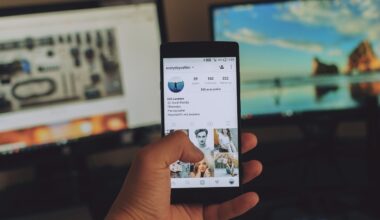Tailoring Images for Paid Social Media Advertising
In the current digital landscape, social media advertising has become essential for brands aiming to enhance visibility and engagement. Tailoring images effectively can significantly influence your marketing campaigns. The visual aspect of advertisements can either grab attention or be overlooked. With the right design approach, images can evoke emotions, drive traffic, and ultimately convert viewers into customers. Optimizing imagery specifically for social media platforms requires understanding their algorithm preferences, recommended sizes, and best practices. Ensure that your images are not overly cluttered; simplicity often results in greater impact. Choose colors and designs that align with your brand identity while piquing interest in the target audience. Visual content should consistently resonate and reflect themes that are prevalent in social trends. Moreover, testing different variations of the image can lead to insightful data on performance. Remember to analyze click-through rates, engagement levels, and conversion metrics associated with each ad’s image. Utilize this feedback to perfect future designs and maximize returns on your investment. With attention to detail, you can ensure your visuals stand out in the crowded social media space, boosting the overall performance of your advertising campaigns.
To ensure that your images effectively convey your branding message, it is crucial to focus on certain elements. Start by employing high-quality visuals that reflect your brand’s ethos. Blurry or poorly composed images can tarnish credibility. You may also consider including your logo in a subtle manner, helping to increase brand recognition. Remember that images should be relevant to the message conveyed in the text or accompanying content. When users identify consistency between imagery and message, they’re more likely to interact positively. One effective strategy involves using people in your images. Human faces generate emotions, fostering connection and relatability. Further enhance engagement by making use of local imagery that reflects regional characteristics, if applicable. People often resonate well with images that appear authentic and relatable to their own experiences. Aspects like color psychology can enhance emotional responses too. Brighter colors often evoke excitement, while softer tones may invoke tranquility. Additionally, don’t neglect platform-specific optimizations. Each social platform may have different optimal image sizes, so adjust accordingly to avoid unintended cropping or compression, which can damage quality and overall appearance.
Image Formats and Accessibility Considerations
The choice of image format holds significant weight in digital advertising for social media. You should familiarize yourself with different formats, each tailored for specific purposes. For example, JPEGs are excellent for photographs but may lose quality after repeated editing. PNGs are better suited for images featuring text, offering greater clarity. When using infographics or content-heavy images, consider employing SVG formats. They stay sharp, regardless of size, making them ideal for responsive designs. In the pursuit of better performance, you may also wish to explore WebP format, which provides high-quality visuals at smaller file sizes. Furthermore, image accessibility must be a priority as it broadens your reach. Add alt text to your images to aid visually impaired users, ensuring that everyone can engage with your content. Alt text descriptions should be concise yet descriptive, facilitating comprehension of visual elements. Compression tools can help optimize loading times, improving the overall user experience. Quick loading times prevent user frustration and can positively influence engagement metrics. Optimize every image meticulously while adhering to best practices to fortify your advertising strategy.
A/B testing represents a crucial aspect of refining your social media advertising images. This method allows you to compare different versions of your ads to identify which performs better. Begin by selecting a few variations of your imagery, then serve them to segments of your audience simultaneously. Review the performance based on metrics like engagement rates, click-through rates, and conversions. When testing, ensure that changes are focused on one aspect at a time, allowing you to clearly understand the impact of that specific change. Small modifications, such as image color, layout, or the presence of a call-to-action, can lead to substantial differences in performance. Gather insights from these tests and use them to inform future campaigns. Keep in mind that trends and audience preferences can shift over time, necessitating regular reviews of your images. Seasonal adjustments may enhance relevance as holidays or special events approach, improving user connection. Engaging with your audience through comments and reviews can provide qualitative insights into what works or what doesn’t. Utilize this feedback as part of your comprehensive optimization strategy.
Utilizing User-Generated Content
User-generated content offers a compelling way to enhance your paid social media advertising efforts. By integrating visuals created by your customers, you can promote authenticity and build trust. Encourage satisfied customers to share their experiences with your products through images. When potential customers see real people enjoying your product, they may become more inclined to make a purchase. Establishing a unique hashtag for your brand can facilitate this process by enabling users to easily find and share their content. Once you collect user-generated images, incorporate them into your advertising campaigns. This not only showcases your product in a natural setting but also engages your community, inviting further participation. Social proof from fellow consumers can substantially influence purchasing behavior and elevate brand credibility. However, ensure to ask permission for the use of users’ images in advertisements, as respect for customer rights is essential. Use clear calls-to-action urging customers to create and share content for better engagement. Promotional incentives can also encourage participation, leading to increased customer loyalty. By intelligently leveraging user-generated visuals, you can create advertisements that resonate authentically with your target audience.
In terms of social media advertising, seasonal imagery can significantly enhance engagement during particular times of the year. Customizing your visuals to align with holidays or events provides an opportunity to resonate emotionally with your audience. Seasonal themes allow you to build excitement and anticipation among potential customers. Consider incorporating traditional colors, symbols, or festivities that align with significant events throughout the year. For example, vibrant colors and festive motifs can create excitement during holiday seasons. Nostalgia can be a powerful motivator; consider leveraging it to foster connections with your audience. As consumers engage with your content during these times, your advertisements will portray relevance. Utilize bright, attention-grabbing imagery; ensure it complements your core message effectively. Moreover, responding to visual trends, such as popular memes or current societal events, can enhance interaction rates with your audience. Timing is crucial; your visuals should hit the audience at the right moment to create a significant impact. Review analytics regularly to gauge which seasonal themes resonate most with your audience, allowing for continuous improvement. For your advertising strategy to remain dynamic, stay updated on emerging trends and seasonal shifts.
Final Thoughts on Image Optimization
In conclusion, optimizing images for paid social media advertising is a multifaceted endeavor that significantly impacts overall campaign success. From understanding the appropriate formats and sizes to incorporating user-generated content, every detail matters. Consistency in brand representation across all imagery is critical for establishing recognition. Utilizing quality visuals paired with strategic seasonal and contextually relevant themes creates a potent resonance with targeted audiences. Thorough A/B testing remains a recommended approach, allowing you to discover the best-performing visuals and copy. Don’t overlook the importance of measuring performance. Utilize metrics like engagement rates, conversions, and audience feedback to make informed decisions. Optimizing images isn’t a one-time action; it requires ongoing effort and adaptation to shifting trends and consumer preferences. The digital landscape evolves continuously, prompting the necessity to remain agile and responsive to audience needs. Additionally, keep an eye on emerging technologies in visual content, such as augmented reality or immersive experiences, which can redefine engagement strategies. Ultimately, your approach to social media image optimization will shape your brand identity and influence how effectively you capture audience interest and loyalty.


